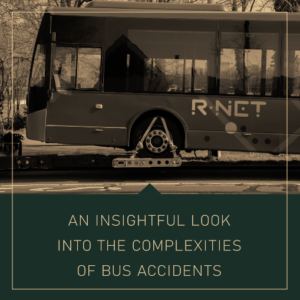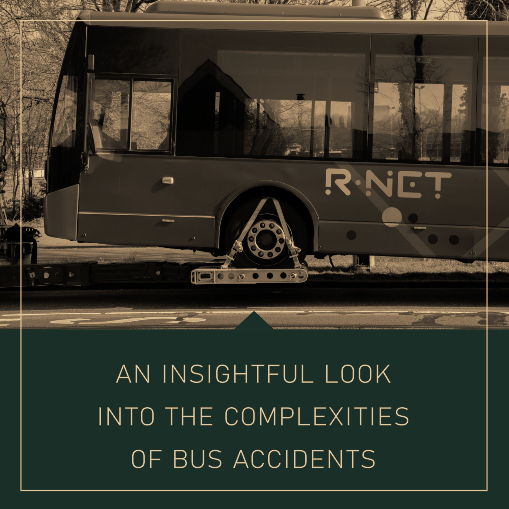
Often, bus accidents occur due to various reasons ranging from negligence on the bus driver’s part to external factors such as environmental conditions or the involvement of other vehicles. For instance, the bus traveling westbound may experience sudden changes in weather or unexpected road conditions that could lead to a mishap. However, human factors like errors from the bus driver or other motorists also significantly contribute to accidents.
A primary concern is understanding the different dynamics involved in such accidents. Each incident, whether a Greyhound bus or a school bus, has unique elements that require careful examination. Typically, an initial investigation carried out by state police identifies these components that are crucial while building a legal case.
As an expert bus accident lawyer, part of my role involves liaising with the state police to ensure a comprehensive investigation takes place. Analyzing the scene, examining evidence from vehicles, and evaluating the testimonies of passengers and witnesses are integral to this process. This rigorous analysis helps to piece together the series of events leading to a bus crash and pinpoint liability accurately.
Profound Impacts of Greyhound Bus Crashes
Such tragedies like Greyhound bus crashes generally impact many people due to the high passenger capacity of these vehicles. In some of the worst cases coming out of Southern Illinois, these accidents result in multiple fatalities and larger numbers of injured victims. In the immediate post-accident scene, ambulances, helicopter evacuation services, and trauma teams at the hospital work tirelessly, prioritizing the injured to give them the best possible care.
An integral part of a legal proceeding following a Greyhound bus crash involves the victim—a passenger, pedestrian, or another road user—and their damages. Preliminary assessments typically involve determining the extent of physical injuries, psychological trauma, and other potential losses. Once assessed, as a bus accident lawyer, my responsibility shifts to quantifying these damages in financial terms to seek rightful compensation on behalf of my clients.
Moreover, dealing with high casualty accidents often involves cases where multiple claimants stake their claims. Managing these claims while ensuring a fair distribution of compensation from insurance becomes a crucial function. Navigating through such multi-claimant situations requires careful handling and adept negotiation skills, which help obtain a desirable outcome for the affected parties.
Complexities of Septa Bus Crashed Cases
Septa bus crashes are not any less complicated in comparison to Greyhound bus accidents. An accident involving Septa buses often brings about legal challenges. One peculiar challenge includes dealing with the bus line’s legal team, which usually adopts numerous strategies to minimize potential payouts to injured victims.
A critical part of this process involves dissecting the statements from passengers and investigating the many facets surrounding the accident. Quite often, such investigations rely on video footage from security cameras installed inside the bus or positioned strategically along the road. Besides this, gathering testimonies from passengers, bus drivers, and other witnesses can greatly contribute to case building.
Furthermore, in larger bus accidents involving Septa, you may find additional complexities when other vehicles are involved, such as three tractor-trailers. These scenarios extend the sphere of investigation as they bring in more parties to the case, thereby making the process more intricate. The key lies in meticulously analyzing each bit of evidence, unraveling facts necessary for validating claims, and ensuring the successful pursuit of justice.
The Role of a Bus Accident Lawyer
A bus accident lawyer is a vital link between the victims and the justice they deserve. Upon being notified of an accident, the lawyer springs into action, beginning with collecting and preserving evidence. This can range from video footage of the bus crash to photographs, witness statements, and police reports. Everything is crucial in building a strong case.
Often the lawyer has to liaise with officials from related authorities such as state police and hospital administrators. The communication helps gather all critical information about the accident on time and accurately. The lawyer’s role is also to protect the victim’s rights as they navigate the complex injury claims process.
The bus accident lawyer also understands that the damages from a bus accident extend beyond physical injuries. They assess the victims’ economic loss, pain and suffering, emotional distress, and future care needs. The quantification of these damages forms the basis of the claim that the lawyer files in court or negotiates with the insurance company.
Rest Stops: Unexpected Scenes of Accidents
Bus accidents might happen anywhere. They could occur on a busy city street, on a quiet country road, or even in seemingly safe places like rest stops. In July, there was a case where a Greyhound bus crashed into a rest area off an exit ramp, traveling westbound. Here, unlike typical accidents, determining liability proves to be slightly more intricate.
In such cases, examining variables like the condition of the rest stop, the bus speed, the driver’s actions, and any other external factors is crucial. For example, was the rest area poorly designed or in a state of decay that could have contributed to the accident? Could the bus driver have done something different to avoid the accident?
As a professional bus accident lawyer, overcoming such challenges forms part of the job. Detailed investigations, employing experts for technical assessments, and analyzing data from different sources help build firm cases. The goal remains to get victims disaster aid as quickly as possible, maintain their rights, and secure the most favorable outcomes.
Common Types of Bus Accidents
Intersection Accidents
One of the common types of bus accidents occurs in intersections where bus drivers have to navigate through complex situations involving other vehicles, pedestrians, cyclists, and even inanimate objects. With their large size and less maneuverability, buses can easily cause an accident if a driver misjudges a turn, fails to notice a stop signal, or cannot spot a smaller road user.
Rollover Accidents
Similar to trucks, buses are also vulnerable to rollover accidents. These accidents typically occur when the bus driver loses control due to high speeds, sudden maneuvers, or external factors such as slippery roads or harsh weather conditions. Rollover accidents are particularly dangerous because of the bus’s number of passengers and the potential for multiple injuries or fatalities.
Head-On Collisions
Head-on collisions involving buses are another common yet devastating type of accident. Often, these accidents occur due to driver errors such as distracted or impaired driving, fatigue, or reckless driving behaviors like overtaking in unsafe conditions or driving in the wrong lane. The high fatalities and injuries in head-on bus collisions make them one of the most tragic bus accidents.
Pedestrian Accidents
Buses pose a significant risk to pedestrians due to their size and numerous blind spots. Also, since buses frequently operate in populated urban areas, the likelihood of pedestrian accidents is notably high. Bus-pedestrian accidents usually occur during pick-up or drop-off times when passengers get on or off buses or are forced to walk close to buses in crowded bus terminals.
Rear-End Accidents
Given their considerable size and weight, buses require a longer stopping distance than smaller vehicles. Therefore, a rear-end collision often occurs if a bus driver doesn’t maintain a sufficient following distance or if the vehicle directly in front stops abruptly.
The different nature of these common bus accidents underscores the importance of driving safely and responsibly around buses. Victims or their families should connect with a bus accident lawyer to help them navigate the legal complexities and assert their rights for proper compensation if an accident still occurs.
Accident Scenes: Putting the Pieces Together
A bus accident scene is usually flooded with first responders, medical personnel, state police, and often, news crews. For someone injured in a crash, it can be a chaotic, confusing, emotional, and painful environment. But even amidst this chaos, it’s crucial for critical evidence to be collected.
First, state police conduct an initial investigation of the accident scene. They assess the situation, secure the area, and allow access to other emergency response entities like ambulances, fire services, and casualty response units. They’ll also typically record video and take photographs of the scene, which can later be used as vital evidence.
The scene may quickly be cleared to allow traffic to pass, but it’s still a rich source of potential evidence. This is where tire marks can reveal a bus’s path, broken glass can show the point of impact, and debris can indicate the severity of the crash. As a bus accident lawyer, revisiting the scene, reviewing video footage, and taking note of every small detail can lead to crucial discoveries that could turn a case.


Leave A Comment